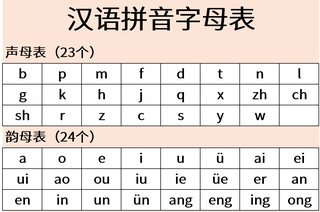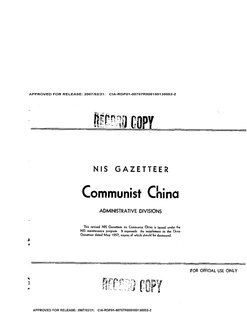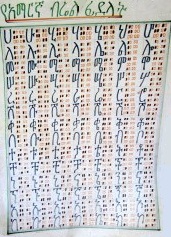
Hanyu Pinyin, often abbreviated to pinyin, is the official romanization system for Standard Mandarin Chinese in mainland China and to some extent in Taiwan and Singapore. It is often used to teach Standard Mandarin, which is normally written using Chinese characters. The system includes four diacritics denoting tones. Pinyin without tone marks is used to spell Chinese names and words in languages written with the Latin alphabet and also in certain computer input methods to enter Chinese characters.

Wade–Giles is a romanization system for Mandarin Chinese. It developed from a system produced by Thomas Francis Wade, during the mid-19th century, and was given completed form with Herbert A. Giles's Chinese–English Dictionary of 1892.
A syllable is a unit of organization for a sequence of speech sounds typically made up of a syllable nucleus with optional initial and final margins. Syllables are often considered the phonological "building blocks" of words. They can influence the rhythm of a language, its prosody, its poetic metre and its stress patterns. Speech can usually be divided up into a whole number of syllables: for example, the word ignite is made of two syllables: ig and nite.

A rime dictionary, rhyme dictionary, or rime book is an ancient type of Chinese dictionary that collates characters by tone and rhyme, instead of by radical. The most important rime dictionary tradition began with the Qieyun (601), which codified correct pronunciations for reading the classics and writing poetry by combining the reading traditions of north and south China. This work became very popular during the Tang dynasty, and went through a series of revisions and expansions, of which the most famous is the Guangyun (1007–1008).
Historical Chinese phonology deals with reconstructing the sounds of Chinese from the past. As Chinese is written with logographic characters, not alphabetic or syllabary, the methods employed in Historical Chinese phonology differ considerably from those employed in, for example, Indo-European linguistics; reconstruction is more difficult because, unlike Indo-European languages, no phonetic spellings were used.
General Chinese is a diaphonemic orthography invented by Yuen Ren Chao to represent the pronunciations of all major varieties of Chinese simultaneously. It is "the most complete genuine Chinese diasystem yet published". It can also be used for the Korean, Japanese, and Vietnamese pronunciations of Chinese characters, and challenges the claim that Chinese characters are required for interdialectal communication in written Chinese.

Cantonese Braille is a braille script used to write Cantonese in Hong Kong and Macau. It is locally referred to as tim chi 'dot characters' or more commonly but ambiguously tuk chi 'raised characters'. Although Cantonese is written in Chinese characters, Cantonese Braille is purely phonetic, with punctuation, digits and Latin letters from the original Braille. It can be mixed with English text.
This pinyin table is a complete listing of all Hanyu Pinyin syllables used in Standard Chinese. Each syllable in a cell is composed of an initial (columns) and a final (rows). An empty cell indicates that the corresponding syllable does not exist in Standard Chinese.
The SASM/GNC/SRC romanization of Tibetan, commonly known as Tibetan pinyin or ZWPY, is the official transcription system for the Tibetan language for personal names and place names in China. It is based on pronunciation of China National Radio's Tibetan Radio pronunciation, which is the Lhasa dialect of Standard Tibetan and reflects the pronunciation except that it does not mark tone. It has been used within China as an alternative to the Wylie transliteration for writing Tibetan in the Latin script since 1982.

(Mainland) Chinese Braille is a braille script used for Standard Mandarin in China. Consonants and basic finals conform to international braille, but additional finals form a semi-syllabary, as in zhuyin (bopomofo). Each syllable is written with up to three Braille cells, representing the initial, final, and tone, respectively. In practice tone is generally omitted as it is in pinyin.
Erhua ; also called erization or rhotacization of syllable finals) refers to a phonological process that adds r-coloring or the "er" sound to syllables in spoken Mandarin Chinese. Erhuayin is the pronunciation of "er" after rhotacization of syllable finals.
The spelling of Gwoyeu Romatzyh (GR) can be divided into its treatment of initials, finals and tones. GR uses contrasting unvoiced/voiced pairs of consonants to represent aspirated and unaspirated initials in Chinese: for example b and p represent IPA [p] and [pʰ]. The letters j, ch and sh represent two different series of initials: the alveolo-palatal and the retroflex sounds. Although these spellings create no ambiguity in practice, readers more familiar with Pinyin should pay particular attention to them: GR ju, for example, corresponds to Pinyin zhu, not ju.

The different varieties of Chinese have been transcribed into many other writing systems.
This article summarizes the phonology of Standard Chinese.
The phonology of Burmese is fairly typical of a Southeast Asian language, involving phonemic tone or register, a contrast between major and minor syllables, and strict limitations on consonant clusters.
The Fuqing dialect, or Hokchia, is an Eastern Min dialect. It is spoken in the county-level city of Fuqing, China, situated within the prefecture-level city of Fuzhou. It is not completely mutually intelligible with the Fuzhou dialect.

Taiwanese Braille is the braille script used in Taiwan for Taiwanese Mandarin (Guoyu). Although based marginally on international braille, most consonants have been reassigned; also, like Chinese Braille, Taiwanese Braille is a semi-syllabary.
In Middle Chinese, the phonological system of medieval rime dictionaries and rime tables, the final is the rest of the syllable after the initial consonant. This analysis is derived from the traditional Chinese fanqie system of indicating pronunciation with a pair of characters indicating the sounds of the initial and final parts of the syllable respectively, though in both cases several characters were used for each sound. Reconstruction of the pronunciation of finals is much more difficult than for initials due to the combination of multiple phonemes into a single class, and there is no agreement as to their values. Because of this lack of consensus, understanding of the reconstruction of finals requires delving into the details of rime tables and rime dictionaries.

Ge'ez Braille is the braille alphabet for all Ethiopic languages. Letter values are mostly in line with international usage.
The Cantonese Transliteration Scheme, sometimes called Rao's romanization, is the romanisation for Cantonese published at part of the Guangdong Romanization by the Guangdong Education department in 1960, and further revised by Rao Bingcai in 1980. It is referred to as the Canton Romanization on the LSHK character database.







